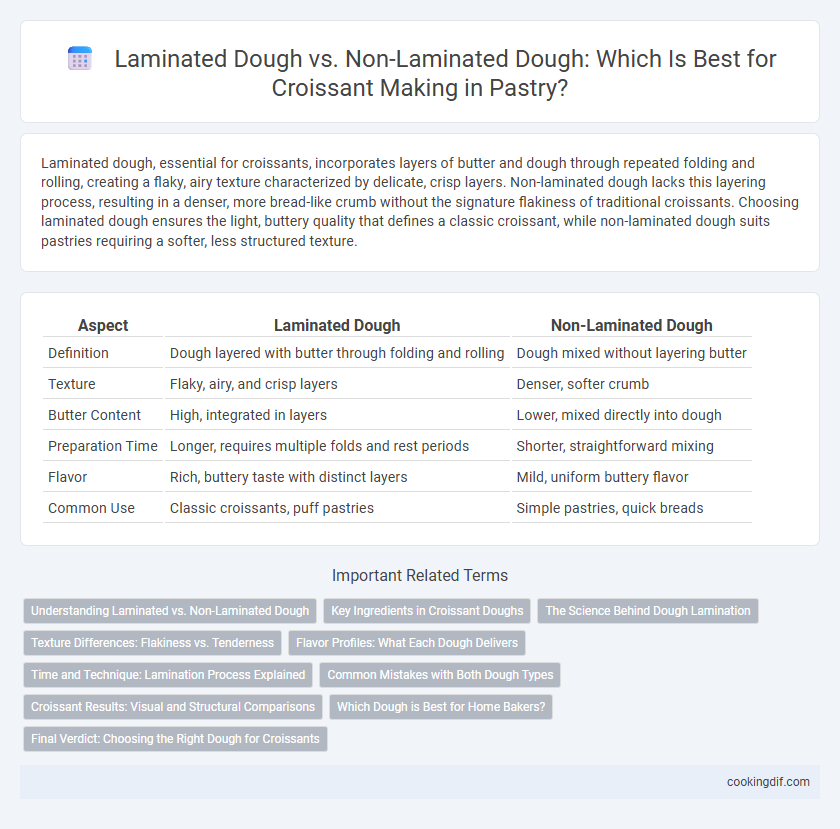Laminated dough, essential for croissants, incorporates layers of butter and dough through repeated folding and rolling, creating a flaky, airy texture characterized by delicate, crisp layers. Non-laminated dough lacks this layering process, resulting in a denser, more bread-like crumb without the signature flakiness of traditional croissants. Choosing laminated dough ensures the light, buttery quality that defines a classic croissant, while non-laminated dough suits pastries requiring a softer, less structured texture.
Table of Comparison
| Aspect | Laminated Dough | Non-Laminated Dough |
|---|---|---|
| Definition | Dough layered with butter through folding and rolling | Dough mixed without layering butter |
| Texture | Flaky, airy, and crisp layers | Denser, softer crumb |
| Butter Content | High, integrated in layers | Lower, mixed directly into dough |
| Preparation Time | Longer, requires multiple folds and rest periods | Shorter, straightforward mixing |
| Flavor | Rich, buttery taste with distinct layers | Mild, uniform buttery flavor |
| Common Use | Classic croissants, puff pastries | Simple pastries, quick breads |
Understanding Laminated vs. Non-Laminated Dough
Laminated dough for croissants features multiple layers of butter and dough folded together, creating a flaky, airy texture through steam expansion during baking. Non-laminated dough lacks these layers, resulting in a denser, more bread-like crumb without the crisp, delicate flakiness characteristic of classic croissants. Mastering laminated dough techniques is essential for authentic croissant production, as it directly affects the pastry's rise, texture, and buttery flavor.
Key Ingredients in Croissant Doughs
Laminated dough for croissants incorporates key ingredients such as high-fat butter, flour with moderate protein content, water, sugar, yeast, and salt, allowing the dough to be layered extensively for its signature flaky texture. Non-laminated dough typically contains similar base ingredients but lacks the repeated folding process that creates distinct layers, resulting in a denser, less flaky product. The quality and temperature of butter, as well as precise flour-to-fat ratios, critically influence the dough's elasticity and rise during baking.
The Science Behind Dough Lamination
Laminated dough involves repeatedly folding and rolling butter into the dough to create multiple thin layers, which evaporate water during baking and generate steam, causing the dough to puff and develop the croissant's signature flaky texture. Non-laminated dough lacks this layered structure, resulting in denser, less airy baked goods due to the absence of steam-driven lift. The lamination process also influences gluten development, balancing elasticity and tenderness to achieve an optimal crumb structure characteristic of authentic croissants.
Texture Differences: Flakiness vs. Tenderness
Laminated dough for croissants creates multiple thin layers of butter and dough, resulting in a flaky, crisp texture with distinct, airy pockets. Non-laminated dough produces a tender, soft crumb without the characteristic flakiness, offering a denser but more delicate bite. The lamination process is essential for achieving the signature lightness and crunch of classic croissants.
Flavor Profiles: What Each Dough Delivers
Laminated dough in croissant making delivers a rich, buttery flavor with a flaky, layered texture due to multiple layers of butter folded into the dough, creating a delicate crispness and deep, caramelized notes. Non-laminated dough produces a denser, bread-like flavor with a softer crumb and less pronounced butteriness, offering a more straightforward, yeasty taste. The laminated dough's complex flavor profile often appeals to those seeking a classic, indulgent croissant experience, while non-laminated dough suits preferences for a simpler, more tender pastry.
Time and Technique: Lamination Process Explained
Laminated dough, essential for authentic croissants, requires multiple precise folds and turns of butter within the dough, extending the preparation time to several hours or even overnight for optimal layering. Non-laminated dough skips this intricate lamination, resulting in quicker preparation but a denser, less flaky texture. Mastery of the lamination technique ensures the croissant's signature air pockets and delicate, crisp layers, highlighting the balance between time investment and pastry quality.
Common Mistakes with Both Dough Types
Common mistakes with laminated dough for croissants include overworking the dough, which leads to tough texture, and improper layering that reduces flakiness. Non-laminated dough errors often involve insufficient gluten development or incorrect hydration, resulting in dense or crumbly pastries. Both dough types suffer when dough temperature is not carefully controlled, affecting yeast activity and final rise.
Croissant Results: Visual and Structural Comparisons
Laminated dough produces croissants with distinct, flaky layers and a golden, crispy exterior, thanks to the multiple folds of butter and dough that create steam pockets during baking. Non-laminated dough croissants result in a denser crumb and a more uniform, bread-like texture without visible layers or sharp flakiness. Visually, laminated croissants exhibit well-defined, airy laminations and a glossy finish, while non-laminated versions have a matte surface and compact structure.
Which Dough is Best for Home Bakers?
Laminated dough, consisting of multiple layers of butter and dough, creates the classic flaky texture essential for authentic croissants but requires precise temperature control and extensive folding, making it challenging for home bakers. Non-laminated dough, often enriched and softer, offers a simpler, quicker alternative with less risk of butter melting or dough tearing, suitable for beginners seeking a tender but less flaky pastry. Home bakers aiming for traditional croissants benefit from laminated dough mastery, while those prioritizing ease and consistency may prefer non-laminated options.
Final Verdict: Choosing the Right Dough for Croissants
Laminated dough, characterized by its multiple layers of butter and dough, produces flaky, airy croissants with a delicate crispness, ideal for traditional French-style pastries. Non-laminated dough offers a denser, more bread-like texture, suitable for simpler, quicker recipes but lacks the signature buttery layers. For authentic croissants, laminated dough remains the superior choice due to its texture, flavor, and classic appeal.
Laminated dough vs non-laminated dough for croissant making Infographic

 cookingdif.com
cookingdif.com